Imagine a world where AI in manufacturing runs plants efficiently, intelligently, and with minimal human intervention. This vision is becoming a reality thanks to the transformative power of artificial intelligence (AI) in manufacturing. The manufacturing industry is experiencing a revolution as AI applications streamline plant operations, improve quality control, and optimize supply chains. So, what does this mean for the near future of AI in manufacturing? Let’s delve into the world of AI and explore the ways it’s reshaping the manufacturing landscape, making it more efficient, productive, and innovative than ever before.
Short Summary
AI has revolutionized the manufacturing industry, enabling increased productivity and cost savings.
Machine Learning and Computer Vision are used to optimize inventory management, detect defects quickly, streamline operations with RPA, enhance equipment performance through PdM systems.
Manufacturers must invest in AI to unlock greater efficiency while overcoming challenges such as acquiring specialized expertise and adapting new technologies.
The Evolution of AI in Manufacturing

The journey of AI in the manufacturing process began in the 1970s with computer-assisted design (CAD) and computer numerical control (CNC) machines, which made use of manufacturing data to optimize design and production processes for individual machines. Fast forward to the present day, and we are now witnessing the dawn of Industry 4.0 – a big data–driven revolution that encompasses ai technology and advanced manufacturing technologies such as AI, robotics, and the Industrial Internet of Things (IIoT).
AI tech solutions have come a long way, and their impact on the manufacturing sector is profound. From quality control and process optimization to robotics and predictive maintenance, AI is transforming the industry at an unprecedented pace. This innovative technology not only enhances the capabilities of manufacturing plants, and robotic workers, but also improves worker interactions with AI-enabled tools, resulting in:
Smarter and more efficient supply chains
Increased productivity and output
Improved product quality and consistency
Enhanced worker safety
Cost savings through reduced downtime and waste
The integration of AI in manufacturing is revolutionizing the semiconductor industry and opening up new possibilities for growth and innovation.
AI Applications Transforming the Manufacturing Industry
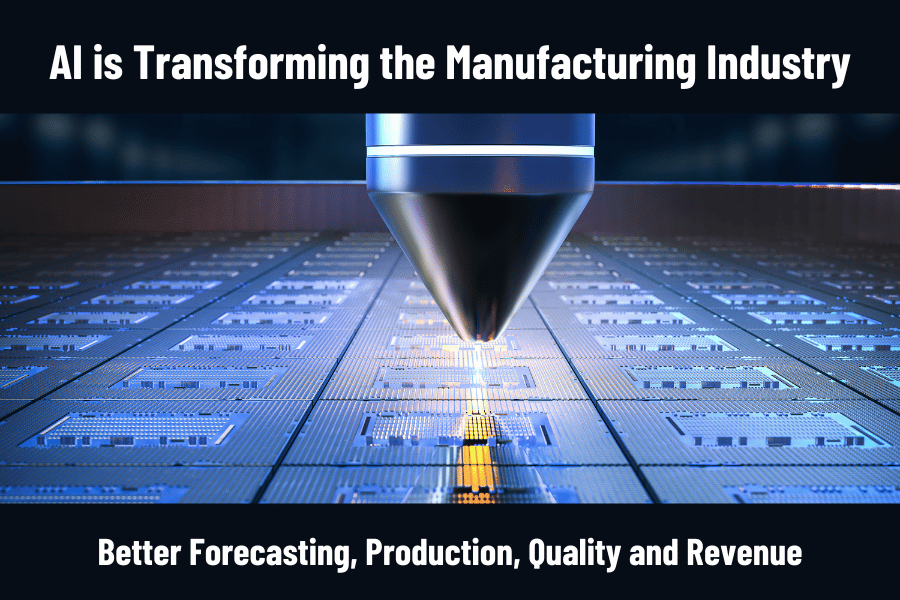
Artificial intelligence is revolutionizing the manufacturing industry by making significant strides in demand forecasting, defect detection, and operational streamlining. These transformative AI applications are powered by machine learning, computer vision, and robotic process automation (RPA). As a result, both large and small manufacturers are reaping the benefits of AI, and smaller manufacturers are experiencing revenue growth and expedited expansion.
In fact, the manufacturing industry has the second-highest rate of AI adoption, with early adopters witnessing tremendous improvements in their bottom line and efficiency. With AI’s significant impact on digital transformation, companies that use AI in manufacturing can now lower costs, reduce downtime, and increase productivity on their production floors.
Machine Learning for Demand Forecasting
Machine learning is a powerful tool for manufacturers when it comes to demand forecasting. By analyzing historical data and employing customer segmentation, machine learning algorithms can detect trends in buying patterns and generate high-demand inventory before it is needed. This not only enhances the accuracy of predictions, but also optimizes inventory management and minimizes costs associated with overstocking or understocking.
Examples of machine learning in demand forecasting include:
Leveraging historical data to predict future demand
Identifying high-demand products
Applying machine learning algorithms for detecting trends in customer behavior
These advancements allow manufacturers to stay ahead of the curve and make informed decisions to meet consumer needs effectively.
Computer Vision and AI Defect Detection
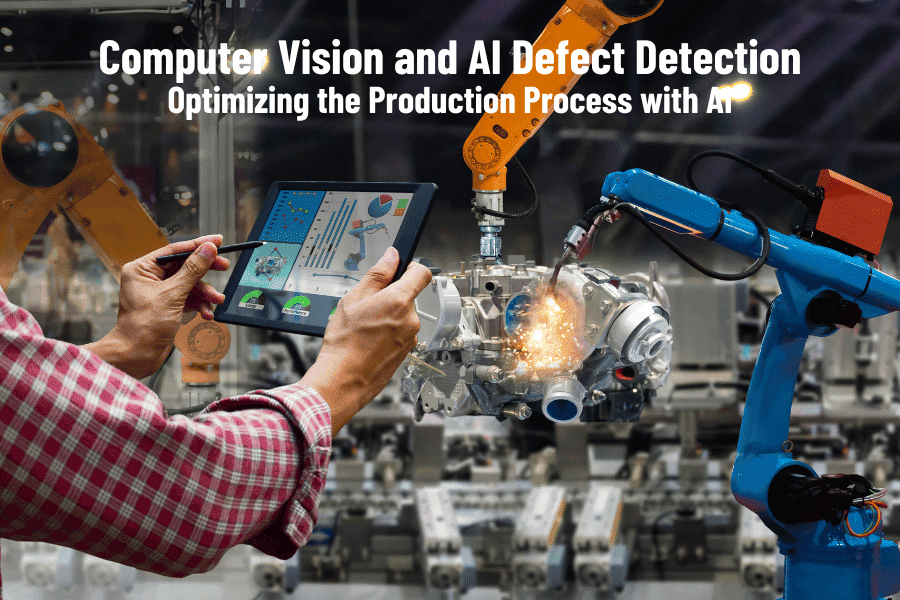
Computer vision technology is revolutionizing the way manufacturers detect defects in production lines. This AI-driven technology uses cameras and algorithms to:
Identify flaws with greater speed and precision than the human eye
Lead to enhanced product quality
Decrease costs
Increase efficiency
In addition to detecting and reporting defects, AI can analyze production data to identify patterns, uncover inefficiencies, and provide opportunities for process improvements. This allows manufacturers to optimize their production process and ensure that their products meet the highest quality standards, giving them an edge in an increasingly competitive market.
Robotic Process Automation for Streamlining Operations
Robotic process automation (RPA) is a game-changer for manufacturing operations. This software technology automates high-volume, repetitive tasks, such as data collection, transfer between systems, calculations, and record maintenance, allowing for streamlined order processing and significant time and cost savings.
By automating these tasks, RPA not only reduces the likelihood of human error, but also allows the workforce to focus on higher-value operations. However, implementing RPA in manufacturing does come with challenges, such as the cost of implementation and the risk of errors due to the complexity of tasks and the absence of human oversight.
The Impact of AI on Human Workers in Manufacturing
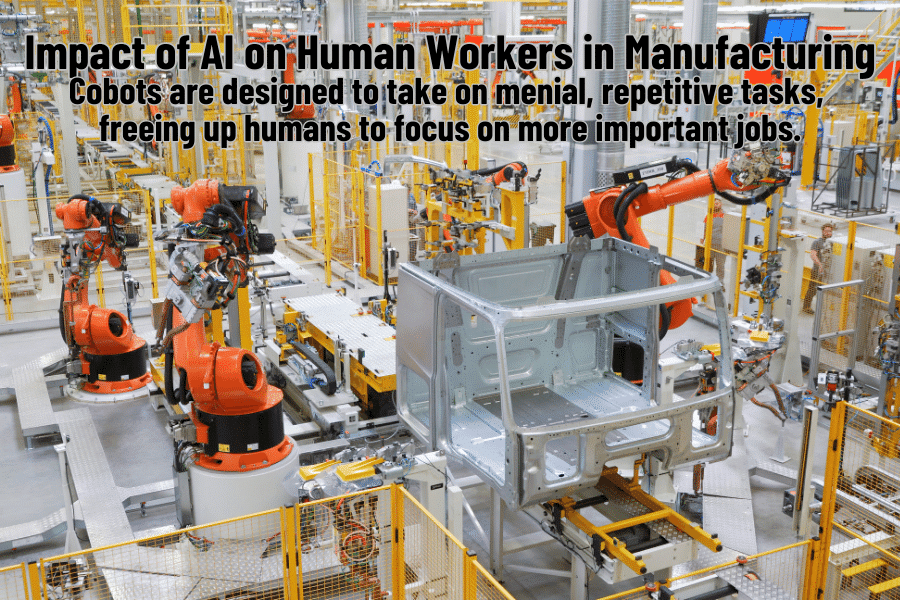
One of the most significant paradigm shifts in the manufacturing industry is the introduction of collaborative robots, or cobots. These autonomous robots work alongside human workers, performing tasks that require heavy lifting or intricate assembly work on factory lines. Contrary to popular belief, AI will not replace traditional robots or eliminate the need for human workers. Instead, cobots are designed to complement and enhance human labor, leading to increased productivity and safety.
Despite the advantages, there are challenges associated with implementing cobots in manufacturing processes, such as costs, specialized training, and potential job displacement by robotic workers. However, the benefits of incorporating cobots into manufacturing processes far outweigh the challenges, paving the way for a more efficient and safer working environment.
Optimizing Supply Chain Management with AI

AI has a massive impact on supply chain management, providing manufacturers with the tools and insights needed to optimize their operations. By leveraging AI systems, manufacturers can effectively monitor supplies, generate alerts when replenishment of raw materials is necessary, and identify bottlenecks in the industry.
Furthermore, AI can help manufacturers in the following ways:
Monitor and track defective products in the supply chain
Identify vehicles constructed with faulty nuts and bolts, allowing manufacturers to quickly withdraw them from dealerships
Optimize supply chain management to increase efficiency and stay competitive in the ever-evolving marketplace.
Enhancing Equipment Performance through Predictive Maintenance

Predictive maintenance (PdM) is an AI-based system that anticipates the servicing needs of manufacturing plants, railroads, and other heavy equipment. By implementing predictive maintenance techniques, manufacturers can decrease downtime, increase efficiency, and extend equipment lifecycles.
In addition to anticipating servicing needs, PdM systems can assist companies in machine maintenance by forecasting the necessary replacement parts and their respective timing. This not only reduces operating costs, but also helps prevent potential safety hazards for personnel. With predictive maintenance, manufacturers can keep their equipment running smoothly and efficiently, ensuring optimal performance and productivity.
The Role of AI in Product Development and Design
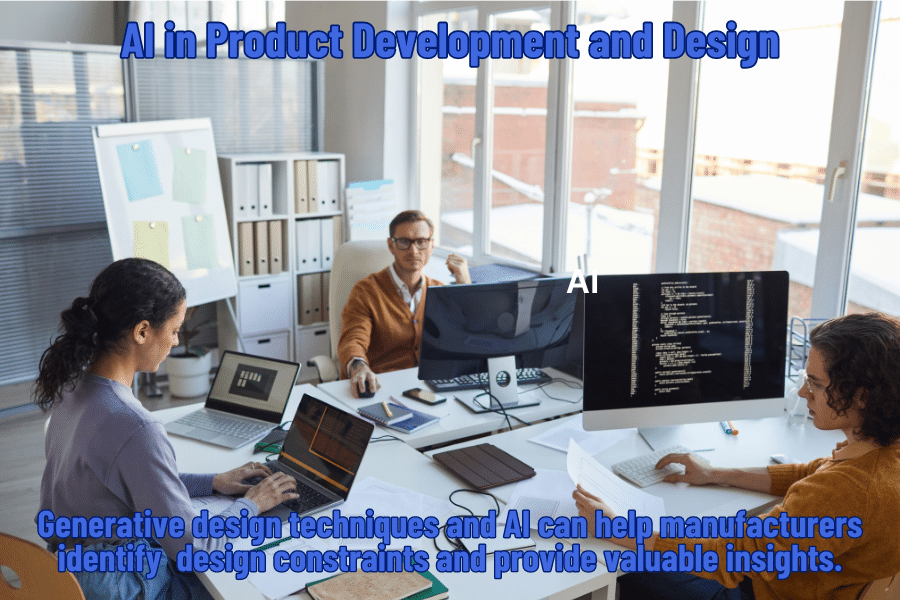
AI plays a significant role in product development and design, streamlining the process and reducing the number of prototypes needed. By utilizing generative design techniques, AI can help manufacturers identify design constraints and provide valuable insights into product usability, enhancing the user experience.
Incorporating AI into product development and design offers several other benefits too.
Accelerates the development process
Supplies insights into customer data to inform design choices
Helps manufacturers stay ahead of the curve
Creates innovative products that meet consumer needs and expectations
Reduces costs and time to market
By leveraging AI, manufacturers can take advantage of these benefits and improve their overall product development and design strategies.
Overcoming Challenges in AI Implementation for Manufacturing
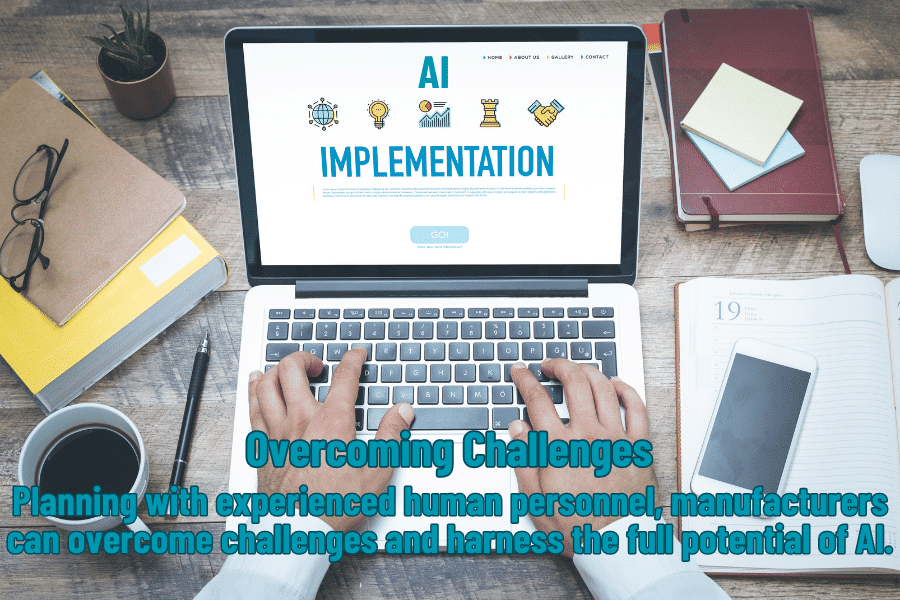
Despite its many benefits, AI implementation in manufacturing is not without challenges. Ensuring error-free integration, acquiring specialized expertise, and adapting to new technologies are some of the hurdles that need to be overcome. Additionally, AI systems, while less error-prone than humans, can still make mistakes, especially when performing complex tasks without human oversight.
Strategic deployment of AI in manufacturing is crucial to maximize its benefits and minimize potential issues. By carefully planning and collaborating with experienced human personnel, manufacturers can overcome these challenges and harness the full potential of AI to revolutionize their operations and stay competitive in the industry.
The Future of AI in Manufacturing

The future of AI and manufacturing is bright, with increased efficiency, productivity, and innovation on the horizon for many manufacturers. As AI technologies continue to advance and become more accessible, manufacturers will need to adapt and overcome the challenges associated with implementing these technologies.
Embracing AI will be essential for manufacturers to stay competitive in the rapidly evolving landscape of Industry 4.0. By investing in AI and focusing on collaboration between human workers and intelligent machines, manufacturers can unlock new levels of efficiency, productivity, and innovation, positioning themselves for success in the years to come.
Summary
In conclusion, AI tech solutions are not only reshaping the future of digital entrepreneurship but they are also reshaping the future of manufacturing. There are a myriad of manufacturing benefits such as improved demand forecasting predictive analytics, enhanced defect detection, streamlined warehouse operations, optimized supply chain management, and more efficient product development and design. As manufacturers navigate the challenges associated with AI implementation, they will need to strategically deploy these technologies and foster a synergistic relationship between human workers and intelligent machines.
The future of AI in manufacturing promises unprecedented efficiency, productivity, and innovation. By embracing AI and overcoming the challenges that come with it, manufacturers can unlock new levels of success and stay at the forefront of industry advancements, ensuring a prosperous and sustainable future in the manufacturing sector.
Frequently Asked Questions
How is AI used in manufacturing?
AI is being utilized by ai systems in manufacturing companies to streamline workflows, automate processes, predict maintenance needs and manage inventory. It also helps identify industry supply chain bottlenecks and analyse sensor data for predicting breakdowns and accidents.
This allows for preventive maintenance and repairs to be scheduled in advance.
What is the future of AI in manufacturing?
AI is revolutionizing manufacturing with its transformational potential, such as: autonomous vehicles, smart factories, automation, predictive maintenance, quality control, and supply chain efficiency. These advances in artificial intelligence are transforming the manufacturing industry and will continue to do so in the future.
What are the challenges of AI in manufacturing?
The implementation of AI in manufacturing presents significant challenges such as the cost and lack of skilled labor, as well as the difficulty of integrating different systems and manufacturing examples which generate data essential to the AI solution. Fragmented systems may prevent successful deployment of AI, which makes managing these issues a top priority for any manufacturer.
What is the main advantage of AI in manufacturing?
AI in manufacturing provides a wealth of advantages, including increased efficiency, productivity and safety, lower costs, plus improved quality control and optimized supply chains.
These advantages are made possible by the use of AI-driven automation, which can identify and respond to changes in the production environment quickly and accurately. This allows for faster and more accurate decision-making, resulting in improved results.
How does AI impact demand forecasting in manufacturing?
Artificial intelligence has revolutionized demand forecasting in manufacturing by enabling machine learning algorithms to analyze vast amounts of historical data, detect trends in buying patterns, and generate high-demand inventory for several manufacturers before it is needed.
AI has allowed manufacturers to better anticipate customer needs and reduce the risk of overstocking or understocking. It has also enabled them to optimize their supply chain and reduce costs associated with inventory management.
AI-driven demand forecasting has become an essential feature.
FREE HIGH DEMAND AI POWERED SOFTWARE PLATFORM: [CLICK HERE TO LEARN MORE]





